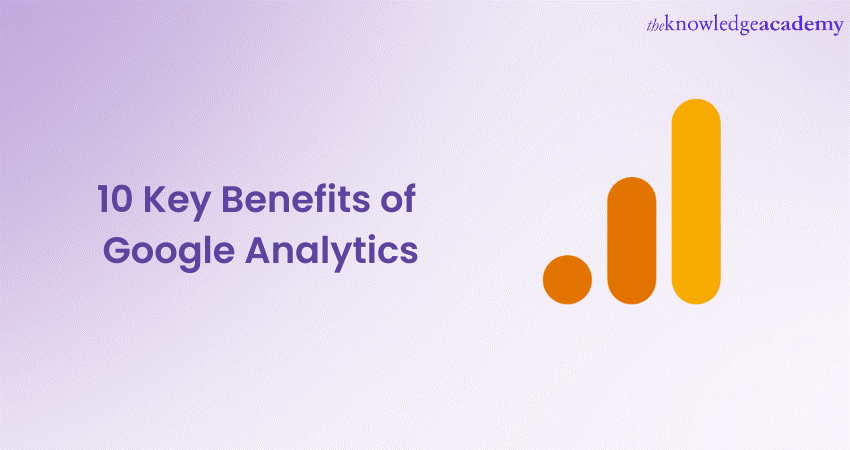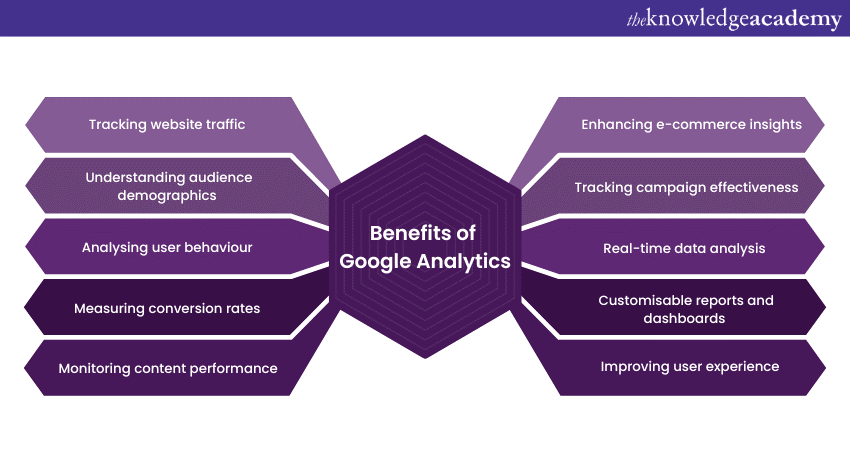We may not have the course you’re looking for. If you enquire or give us a call on +33 805638382 and speak to our training experts, we may still be able to help with your training requirements.
Training Outcomes Within Your Budget!
We ensure quality, budget-alignment, and timely delivery by our expert instructors.

Think about websites as virtual places, like stores or hangout spots, that people visit. Imagine having a magic tool that tells you everything about these virtual places. One of the magic tools that emerged in this field is Google Analytics. There are incredible Benefits of Google Analytics that can help you understand websites better and businesses to grow.
According to Statista, in 2021, Google asserted its dominance in the Web Analytics sector. Among the various Web Analytics technologies leading the pack was Google Analytics, securing the first spot with an impressive market share of 30 per cent. You see the magic of this analytical tool. Read this blog and explore the 10 Key Benefits of Google Analytics and how it helps in informed decision-making with insights into user behaviour.
Table of Contents
1. What is Google Analytics?
2. How does Google Analytics work?
3. Benefits of Google Analytics
a) Tracking website traffic
b) Understanding audience demographics
c) Analysing user behaviour
d) Measuring conversion rates
e) Monitoring content performance
f) Enhancing e-commerce insights
g) Tracking campaign effectiveness
h) Real-time data analysis
i) Customisable reports and dashboards
j) Improving User Experience (UX)
4) Conclusion
What is Google Analytics?
Google Analytics is a powerful digital analysis platform developed by Google, designed to provide comprehensive insights into website and app performance. It collects valuable data about user interactions, traffic sources, and user demographics, presenting them through easy-to-understand reports and dashboards. This tool enables businesses and individuals to track and analyse online activities, understand audience behaviour, measure conversion rates, and optimise digital strategies for improved User Experiences (UX) and overall success.
How does Google Analytics work?
Google Analytics is a tool that helps you measure how people use your website or app. It works by using a small piece of JavaScript code, called a tag, that you put on your website or app. The tag sends information to Google Analytics about what the users do on your website or app, such as which pages they visit, how long they stay, what actions they take, etc. This information is anonymous, which means it does not identify the users personally.
By using Google Analytics, you can access a lot of useful data about your website or app users. For example, you can see how many users visited your website or app, which pages were the most popular, how many users signed up for your newsletter or bought something from you, and so on. You can also see information about the users’ devices, browsers, Operating Systems (OS), and where they came from (such as search engines, social media, or other websites). It helps you understand your users better and improve your website or app accordingly.
Google Analytics has different versions and features that you can use depending on your needs. The latest version is Google Analytics 4 (GA4), which is designed to give more profound user-focused insights with better tracking features. It has a more user-friendly interface and a more event-driven approach, which makes it more adaptable and comprehensive than the previous version, Universal Analytics (UA). It also has better integration with Google Ads and more advanced reporting features and predictive metrics.
Benefits of Google Analytics

Understanding your online audience and tracking the performance of your website is crucial for your business’s success. Google Analytics, a robust Web Analytics tool, offers many benefits that empower businesses and individuals to make informed decisions and optimise their online presence. Here are 10 Benefits of using Google Analytics:
Top tools of Google Analytics
Google Analytics presents a suite of tools designed to offer comprehensive insights into website performance, user behaviour, and audience engagement. These tools facilitate data collection, processing, and visualisation, empowering website owners and marketers to make data-driven decisions. Let’s delve into the technical aspects of the top 10 tools that Google Analytics provides:
Tracking website traffic
Google Analytics offers a mechanism to track and quantify the flow of visitors to your website. It captures data about the number of individuals accessing your website, the pages they view, and the interactions they have during their visits. This data is collected in real-time, providing you with insights into the popularity and engagement levels of your website. It's akin to a digital traffic counter, revealing patterns of user visits and helping you identify trends, peak activity periods, and areas that might require optimisation.
Understanding audience demographics
Google Analytics goes beyond just tracking visits; one of the Benefits of Google Analytics is that it gathers detailed demographic information about your website's visitors. This information includes data like age, gender, geographical location, preferred language, and device preferences.
This demographic profiling provides you with a comprehensive snapshot of your audience. By understanding the specific characteristics of your visitors, you can tailor your website content, layout, and marketing strategies to align with their preferences and behaviours.
Analysing user behaviour
Google Analytics delves into the behaviour of users on your website by meticulously tracking their actions. This involves capturing the order of pages they explore, the duration spent on each page, and the routes they follow on your site. This behaviour information creates a digital track of footsteps that exposes user involvement and interaction trends. Technically, this encompasses seizing user actions and engagements, which can later be scrutinised to comprehend the effectiveness of various parts of your website.
Unlock the secrets of Direct Marketing success with our Direct Marketing Masterclass – Join now!
Measuring conversion rates
Conversion tracking involves the technical implementation of specific tracking codes or triggers that monitor user actions aligned with your business goals. For instance, setting up a conversion goal for completed purchases allows Google Analytics to measure how effectively your website turns visitors into customers.
By comparing the number of conversions against the total number of visitors, you gain insights into the conversion rate. This rate provides an indication of how successful your website is in achieving the desired user actions.
Monitoring content performance
Google Analytics provides a mechanism to measure the effectiveness of your website's content. Through tracking user interactions with individual pieces of content, such as blog posts, videos, or articles, you gain insights into their popularity.
This involves associating specific tracking codes or tags with each content item. This allows Google Analytics to gather data on user engagement metrics like pageviews and time spent. This data aids in understanding which content resonates most with your audience.
Enhancing e-commerce insights
For e-commerce businesses, Google Analytics offers advanced features for tracking user interactions within an online store environment. This involves integrating enhanced e-commerce tracking, which allows the monitoring of user actions related to products, including views, additions to the cart, and completed purchases. These interactions are tracked through technical implementations that capture and report data on user activities within the online shopping process. This data provides valuable insights into product popularity, user preferences, and the effectiveness of your online sales funnel.
Tracking campaign effectiveness
Google Analytics facilitates campaign tracking by utilising UTM parameters and tracking codes. The technical process includes adding UTM parameters to campaign URLs enabling Google Analytics to associate user actions with particular campaigns. Monitoring metrics like click-through rates, bounce rates, and conversion rates for each campaign allows you to evaluate their performance. This technical configuration ensures a precise measurement of the outcomes of diverse marketing endeavours.
Real-time data analysis
Google Analytics offers real-time reporting capabilities, allowing you to access data on user activities as they occur. This involves the constant collection, processing, and reporting of data in near-real-time intervals.
The technical infrastructure of Google Analytics enables the swift capture and presentation of data points without significant delay. This feature is particularly useful for promptly responding to sudden changes in user behaviour or traffic patterns.
Customisable reports and dashboards
The customisability of Google Analytics reports and dashboards are facilitated through the creation of custom dimensions, metrics, and visualisation elements. This involves configuring data collection settings and creating custom segments, dimensions, and metrics that align with your specific analytical needs. These customised elements are then integrated into reports and dashboards. Thus, they allow you to visualise and analyse data in ways that are most relevant to your objectives.
Improving User Experience
The enhancement of User Experience involves a technical evaluation of user behaviour patterns, particularly instances of high engagement and exit points. By monitoring user interactions and analysing data on a technical level, you can identify areas of your website where users may face challenges or encounter barriers.
This analysis informs decisions related to website design, navigation structure, and content presentation, all aimed at creating an engaging User Experience. The technical process involves a systematic review of user interaction data and the implementation of design modifications to address identified issues.
Conclusion
Google Analytics offers unparalleled insights, spotlighting the benefits of understanding user behaviour, optimising site performance, and harnessing audience preferences. Understanding the Benefits of Google Analytics provides you with great insights into how your website works and how to make it top-notch. Its unique tools unwrap visitor insights, fine-tune glitches, and guide savvy choices.
Unlock the power of data with our Google Analytics Masterclass and make informed decisions for digital success!
Frequently Asked Questions
Upcoming Digital Marketing Resources Batches & Dates
Date
 Digital Marketing Course
Digital Marketing Course
Fri 24th Jan 2025
Fri 28th Mar 2025
Fri 23rd May 2025
Fri 25th Jul 2025
Fri 26th Sep 2025
Fri 28th Nov 2025







 Top Rated Course
Top Rated Course



 If you wish to make any changes to your course, please
If you wish to make any changes to your course, please


